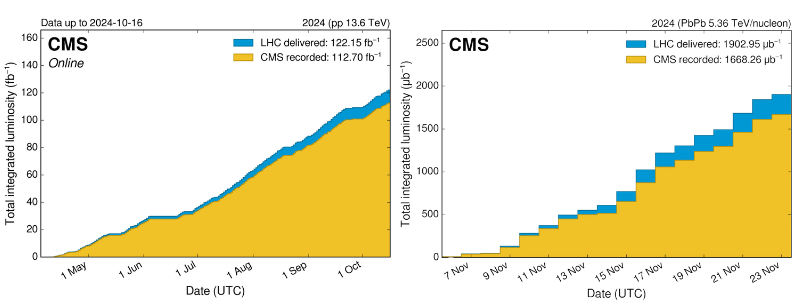
The heavy ion Run has just concluded, marking the start of the extended year-end technical stop (EYETS). Reflecting on 2024, this year’s LHC Run exceeded expectations, delivering the highest accumulated data volume to date. In alignment with this achievement, CMS set a new record for data collection in a single year.
The LHC concluded its tenth year of operations on Monday 25th November 2024, having delivered record numbers (in a single year) of proton-proton (p-p) and lead-lead (Pb-Pb) collisions to the experiments, exceeding expectations. In alignment with this achievement, CMS set a new record for data collection in a single year: more than double the previous record! The 2024/2025 Extended Year End Technical Stop (EYETS) is now underway, an opportunity for CMS to perform maintenance on the detector and prepare for the next LHC run, due to start in May 2025.
The past year featured 21 weeks of p-p running and 4 weeks of Pb-Pb running, accumulating nearly 123 fb⁻¹ (inverse femtobarns) and 1.9 nb⁻¹ (inverse nanobarns) of collisions respectively. One inverse femtobarn corresponds to about 100 trillion (1014) p-p collisions, whilst one inverse nanobarn corresponds to about 17 billion (1010) Pb-Pb collisions.
The p-p running was extremely stable - for both LHC and CMS - but still immensely challenging. In the LHC “bunches” of about 10 billion protons cross inside the detectors. Each time this happens - around 40 million times per second - many individual protons collide, increasing the probability that something interesting happens, but making it more difficult to distinguish particles from different collisions. These multiple collisions are known as “pileup” and CMS was designed to be able to cope with a pileup of 20-25. But LHC and CMS have been exceeding expectations since operations started back in 2010 and, in 2024, the LHC was routinely operating with a pileup around 60! In principle the LHC can reach even higher pileup but this limits the efficiency of data taking by the detectors. The LHC thus performs “luminosity levelling”, to limit the average pileup to a lower rate that can be efficiently digested by the experiments. This is done through careful adjustment of LHC beam parameters. The “levelled” luminosity can be maintained for many hours (normally 7-8 hours) before it gradually decreases and a new “LHC fill” is needed. In 2024 the luminosity levelling was made stable within a 2.5% margin, twice as stable as in 2023, improving the stability of CMS data taking.

Above: The integrated luminosity for pp collisions on the left and PbPb ones on the right, delivered by LHC and recorded by CMS. See the originals here

Above: A comparison of the current 3 years of LHC Run 3 proton-proton collisions in terms of delivered luminosity versus time.

Above: A comparison of the number of interactions per crossing (pileup) distribution for different years of operations, from Run 1 to Run 3.
The fact that CMS can operate efficiently with such high pileup is due to the robustness of the original detector design and the flexibility of the trigger and data acquisition (DAQ) systems. Indeed the High Level Trigger (HLT) farm of computers, that analyse in real time the data from CMS, was expanded with several hybrid CPU+GPU nodes, increasing its computing power by 20%. The stability of the central DAQ system, combined with the experience of both the shifters and the on-call experts, led to an excellent overall efficiency of data taking. And although the Shift Leader, Technical Shifter (safety) and DAQ shifter are based at the CMS site in Cessy, the shifters for the Trigger and Data Quality Monitoring (DQM) can be located elsewhere in the world. Indeed many CMS “Remote Operations Centres” have facilitated this around the world, again improving our overall efficiency.
The Pb-Pb operation was easier for CMS to digest as the collision rate was much lower than for p-p. But as each Pb-Pb collision is far more complex than even high-pileup p-p collisions, there are still significant challenges for the detector, trigger and DAQ. For the heavy-ion data taking a dedicated set of servers with solid-state drives was installed, adding some 250 TB of buffer space, and allowing a DAQ throughput at times exceeding 32 GB/s. This almost doubled the throughput with respect to the original Run-3 DAQ design and, once again, optimized the CMS efficiency for taking good data.
This year CMS also inaugurated its new control room, while the old one is now being transformed to a DAQ room, in preparation for the High-Luminosity LHC phase that is due to begin around 2030. In this phase the pileup will be much higher than now, possibly reaching 200 - requiring significant changes to CMS - but that is another story!

Above: The new CMS control room being finalised. The new control room will be used until the end of Run 3 and throughout the HL-LHC phase.

